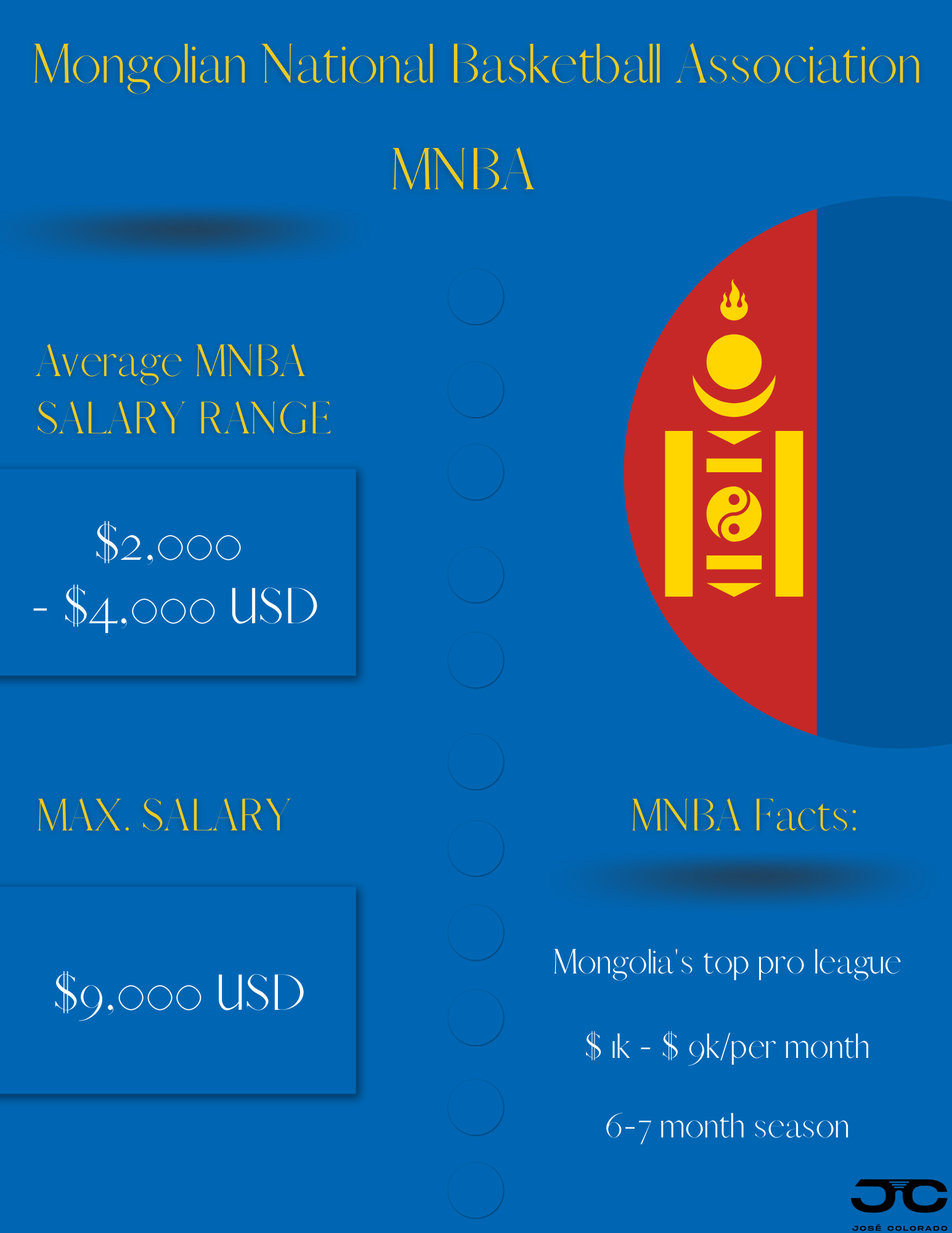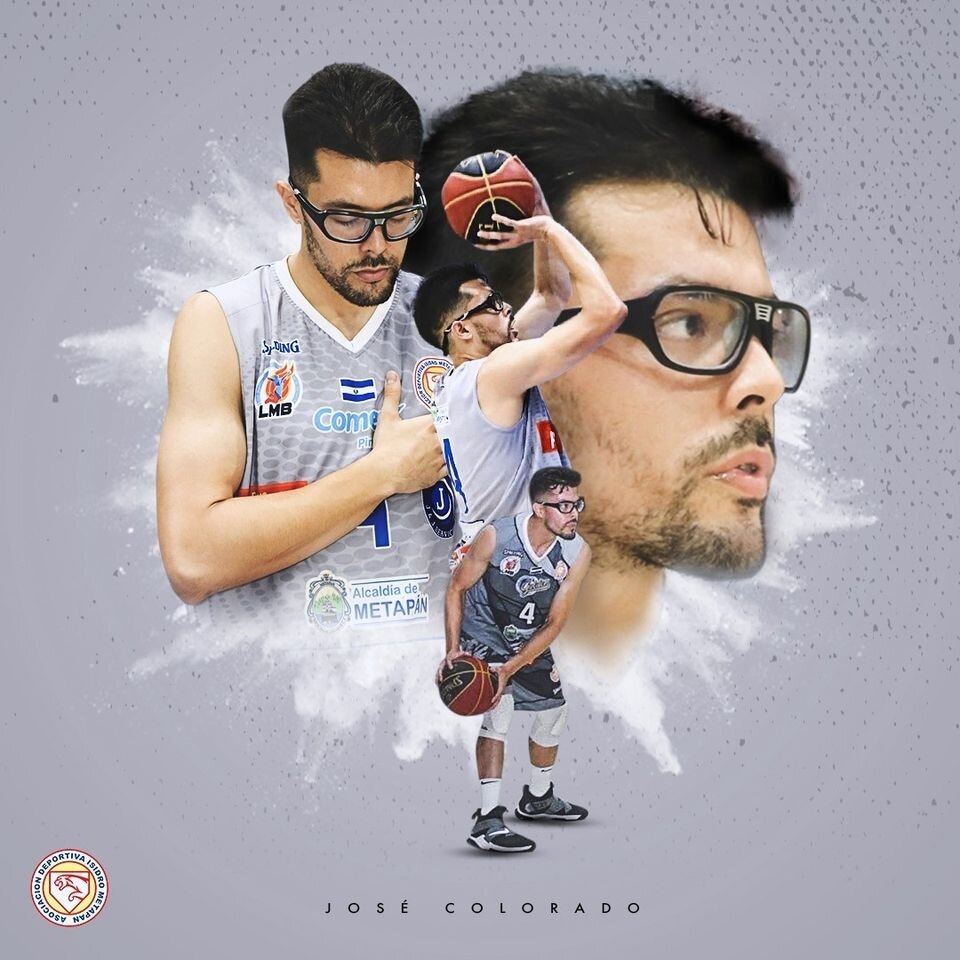Mongolian Basketball League Salary: Mongolian National Basketball Association (Average, Min & Max Salaries)
mongolian basketball league salaries [chart]
|
Player Salary Ranges |
$1,000 - $9,000 USD/per month |
|
Most Commonly Reported Salary |
$2,000 - $4,000 USD/mth |
|
Lowest Reported Salary |
$1,000 USD/mth |
|
MAX Salary (Imports) |
$9,000 USD/yr |
|
Sources Referenced [Players, Media, Coaches, Agents] |
17 |
Source : Josecolorado.com, Professional Basketball Players Survey Data [2022]
Mongolian basketball league salary
Overseas players in Mongolia’s top professional basketball league - the Mongolia National Basketball Association (MNBA) - can typically expect to make $2,000 - $4,000 USD/per month on average.
The lowest salaries hover around $1,000 USD/per month. The MAX is $9,000 USD/per month.
Based on our overseas basketball salaries survey that looked at 100+ leagues worldwide, this would put Mongolia in the middle-lower tier of Asian Basketball salaries.
But:
Overall it would put Mongolia into the middle-tier pay grade of worldwide basketball salaries.
After all:
Asia is the highest-paying basketball continent in the world on average.
Mongolian basketball league salaries vary from $1,000 - $9,000 USD/per month.
Mongolian basketball league:
mongolian national basketball association
Mongolia’s top professional basketball league is the Mongolian National Basketball Association (MNBA) - also known as the ‘SuperLeague’ - where salaries range from $1,000 - $9,0000 USD/per month.
Let’s get more specific though:
First let’s start with lower-budget clubs.
Here we are typically looking at MNBA teams offering $1,000 - $1,500 USD/per month.
Sometimes contracts can dip below $1,000 (rare cases).
In these instances you’d be looking at $500 - $800 - the bottom pay rung of the league.
On the other extreme:
Higher-budget MNBA teams can typically pay a player $4,500 - $10,000 USD/per month.
In fact:
According to Greek newspaper Gazzetta, at least one MNBA club is officially searching for two players between $7,000 - $9,000 USD/per month.
Agents and players with first-hand experience in the MNBA confirmed these larger salary amounts as well.
I had multiple sources directly tell me higher-end players can usually command between $6,000 - $10,0000 USD/per month.
Dwight Howard's RECORD-BREAKING Taiwan Contract (How the T1 League Bent ... https://t.co/HfXdKQbjO4 via @YouTube
— Jose Colorado (@ColoradoURB) March 25, 2023
Plus - there’s bonuses and incentives to include in many cases.
For instance:
Here’s how one player’s contract looked liked:
$8,000 per month (base salary)
$10,000 bonus to reach semi-finals
$15,000 bonus to reach finals
$20,000 bonus if they win entire league
But please understand:
These higher-end salaries are reserved for:
Ex-NBA players
Ex-NBA G-Leaguers
Proven international pros
Average MNBA salary range based on club budget (chart)
|
Type of Club |
Average salary range per month (USD) |
|
Lower-budget MNBA teams |
$800 - $1,500 |
|
Middle-budget MNBA teams (most common) |
$2,000 - $4,000 |
|
Higher-budget MNBA teams |
$4,500 - $9,000 |
Mongolian basketball players
Despite its lower basketball profile in comparison to its neighboring countries of China and Russia, Mongolia has a few notable ties to NBA players including former Los Angeles Lakers guard Smush Parker (MNBA) and NBA Champ Mengke Bateer (Chinese Inner Mongolian).
In 2015, Parker - who infamously played alongside Kobe Bryant on two playoff bound Lakers teams - played for the Mon-Altius Madimos Falcons in the MNBA.
While Parker personally played well in Mongolia averaging 24 points - 7 rebounds - 6.5 assists.
The five-year NBA player was actually eliminated in the first-round on the MNBA competition.
And it appears Parker wasn’t exactly a fan of the Mongolian experience.
“You can quote this as Smush Parker saying, ‘Yo, Mongolia was the worst basketball experience ever,’ ” Parker said. http://t.co/bSw3r64aGO
— Scott Cacciola (@ScottCacciola) July 25, 2015
That shouldn’t exactly come as a huge surprise.
Some countries - for example Bolivia or Peru (altitude sickness) - can provide some serious environmental challenges to get past.
In fact:
The two books pictured below do a great job of outlining just that.
I’d highly recommend reading both (written by ex-pros) to get a better idea of what I’m talking about.
Often times:
Overseas basketball is not just 5v5.
You are also up against unbelievable environmental challenges.
My guess is this played a factor into Parker disliking the experience.
Mongolia’s temperatures can dip to -30 degrees Celsius.
The MNBA season also occurs during the winter months (October - April).
So you can only imagine how dramatic a shift that could be for someone not used to it.
Outside of Parker:
Mongolians can take pride in Mengke Bateer.
The six-foot-eleven (211cm) and 290 lbs (132kg) beast played three NBA seasons with the :
Denver Nuggets (2002)
San Antonio Spurs (2002 - 2003)
Toronto Raptors (2003 - 2004)
And while Bateer did play for the Chinese National Team for many years with Yao Ming, he was officially born in Hanggin Banner, Inner Mongolia.
Bateer even won an NBA championship in 2003 with the San Antonio Spurs.
Mengke Bateer is the highest-paid Mongolian basketball player ever.
highest paid mongolian basketball player: Mengke bateer net worth
As the only Mongolian to make the NBA thus far, Mengke Bateer is also the highest-paid Mongolian basketball player.
In his three seasons in the NBA he netted $1.4 million USD.
Nowadays:
There are many Mongolian basketball players who are attempting to follow in Bateer’s footsteps.
However:
The most well-known example would have to be “Mongolian Mike.”
mongolian mike
Enkhiin-Od Michael Sharavjamts - known more commonly as Mongolian Mike - is the first Mongolian citizen to ever earn a Division 1 basketball scholarship (Dayton Flyers) and to enter the NBA draft.
The 6-8 forward first burst onto the scene in the mid 2010s as a high schooler.
That was when he came over to the United States to play his high school ball in the hopes of furthering his basketball career.
Since then, he committed to the Dayton Flyers and averaged the following in his first year:
5.6 Points Per Game
38.8% FG - 33.3% 3PT
2.6 Assists
.@DaytonMBB's Mike Sharavjamts is the first Mongolian citizen to earn a D-I athletic scholarship.
— CBS Sports College Basketball 🏀 (@CBSSportsCBB) March 12, 2023
"He's a national treasure. Mongolian Mike, that's how we call him." pic.twitter.com/QJIj2uIC5Q
Not exactly shining numbers.
So, maybe, the NBA - for now - seems like a bit of a stretch.
Regardless:
Seeing a Mongolian national making such a big leap is certainly a positive step forward for Mongolia and the MNBA.
After all:
If “Mongolian Mike” is able to gain some traction that could mean:
More potential sponsorships into basketball back in Mongolia
Partnerships
Potential wealthy owners stepping forward wanting to own MNBA teams
Trick down effect into bigger player salaries
is basketball popular in mongolia
Basketball continues to grow in Mongolia. But it is actually 3x3 Basketball that has become the most popular version of the sport.
Horse racing and wrestling are still Mongolia’s most popular sports.
But 3x3 basketball is not too far behind.
Mongolia’s 3x3 basketball is more popular than the traditional 5v5 - something that will impact overseas basketball salaries in Mongolia in the future.
This isn’t something an overseas player should overlook.
Just think about:
Basketball will likely continue to grow and develop in Mongolia.
But if the bulk of the resources are going towards the 3x3 FIBA/Olympic version, then this does little for players who are interested in cashing out in the traditional 5v5 format (i.e. MNBA).
Also:
3x3 is still in its novelty stages and has many people excited.
Even something as unique and different as its multi-coloured official game ball is still appealing and fresh to many (including me).
Much of the country’s attention will be focused on the 3x3 version.
That will leave the MNBA with the table scraps.
And speaking frankly:
There’s a good chance that scenario may just develop in the years to come.
Why is that, you ask?
Mongolia 3x3 basketball
Although achieving little international success in traditional 5v5 basketball, Mongolia has quickly risen to become the No.1-ranked 3x3 Basketball Nation in Asia.
Globally, in both men and women, they are ranked amongst the best countries in the world.
Here’s Mongolia’s 3x3 basketball resume as of 2022:
|
Mongolian 3x3 Men’s Basketball |
|
|
FIBA World Ranking |
No.11 |
|
FIBA Asia Ranking |
No.1 |
|
Players ranked in FIBA Top 250 Players |
14 |
|
Olympic appearances |
None |
|
Mongolian 3x3 Women’s Basketball |
|
|
FIBA World Ranking |
No.7 |
|
FIBA Asia Ranking |
No.1 |
|
Players ranked in FIBA Top 250 Players |
13 |
|
Olympic appearances |
2020 |
Beyond this:
According to star women’s 3x3 player Khulan Onolbaatar, Mongolians have an entire TV channel devoted specifically to 3x3 basketball.
The Washington Post reports roughly 20,000 kids are playing organized 3x3 in Mongolia.
Many die-hards are buying jerseys of star 3x3 players such as Onolbaatar according to the report.
And all of this is craze for 3x3 over 5x5 seems completely justified.
Consider:
The women’s 3x3 earned their berth to the Tokyo Olympics in 2020.
That marked the first time Mongolia ever qualified for a team event at the Olympics.
Mongolia in 5x5 has never come close to that stage in international basketball.
And all of this has been achieved in a short time frame.
Considering that, if you were the Mongolian Basketball Federation - and you had to make a choice - where would you allocate your money into?
That seems like an obvious decision.
But it may not be necessarily what overseas pros want to hear.
CONCLUSION
So there you have it.
The Mongolian National Basketball Association is Mongolia’s top basketball league.
It provides overseas basketball players the opportunity to make decent wages if playing for one of its top clubs.
In the context of Asia, Mongolia has a lower-middle overseas basketball salary.
But in global terms, it is still a serious contender to attract solid hoopers.
What has your experience been like with the MNBA and the Mongolian Basketball League?
Comment below!
Jose Colorado is a 6-year professional basketball player helping others achieve their dreams of pro basketball with a proven and tested approach to overseas basketball.
READ MORE

